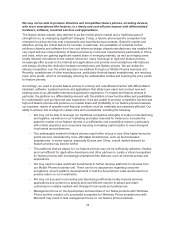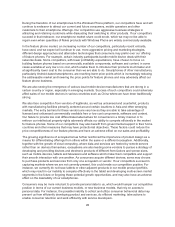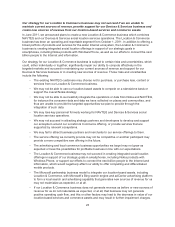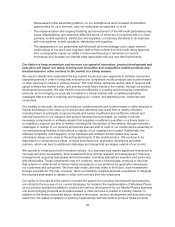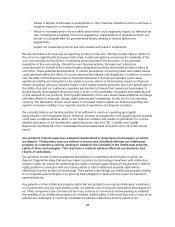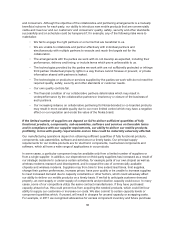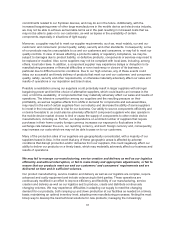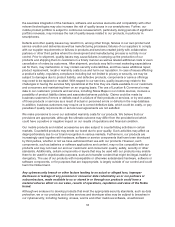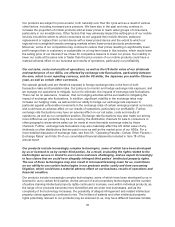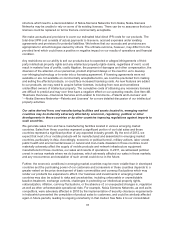Nokia 2011 Annual Report Download - page 30
Download and view the complete annual report
Please find page 30 of the 2011 Nokia annual report below. You can navigate through the pages in the report by either clicking on the pages listed below, or by using the keyword search tool below to find specific information within the annual report.• Result in failures of derivative counterparties or other financial institutions which could have a
negative impact on our treasury operations.
• Result in increased and/or more volatile taxes which could negatively impact our effective tax
rate, including the possibility of new tax regulations, interpretations of regulations which are
stricter or increased effort by governmental bodies seeking to receive taxes more
aggressively.
• Impact our investment portfolio and other assets and result in impairment.
We are domiciled in Europe and our reporting currency is the euro. We face certain risks in relation to
the concerns regarding the European debt crisis, market perceptions concerning the instability of the
euro, the potential re-introduction of individual currencies within the eurozone, or the potential
dissolution of the euro entirely. Should the euro dissolve entirely, the legal and contractual
consequences for holders of euro-denominated obligations would be determined by laws in effect at
such time. These potential developments, or market perceptions concerning these and related issues,
could adversely affect the value of our euro-denominated assets and obligations. In addition, concerns
over the effect of this financial crisis on financial institutions in Europe and globally could cause
significant volatility and disruption to the global economy, which could adversely impact our financial
results, as well as having an adverse impact on the capital markets generally, and more specifically on
the ability of us and our customers, suppliers and lenders to finance their respective businesses, to
access liquidity at acceptable financing costs, if at all, on the availability of supplies and materials and
on the demand for our products. Full or partial dissolution of the euro would cause additional exchange
rate risks related to dividends, foreign cash balances and investments. As the euro is our reporting
currency, the dissolution of euro would result in increased costs to adjust our financial reporting and
result in increased volatility in our reported results of operations and financial condition.
We currently believe our funding position to be sufficient to meet our operating and capital
expenditures in the foreseeable future. However, adverse developments in the global financial markets
could have a material adverse effect on our financial condition and results of operations. For a more
detailed discussion of our liquidity and capital resources, see Item 5B. “Liquidity and Capital
Resources” and Note 34 of our consolidated financial statements included in Item 18 of this annual
report.
Our products include numerous patented standardized or proprietary technologies on which
we depend. Third parties may use without a license and unlawfully infringe our intellectual
property or commence actions seeking to establish the invalidity of the intellectual property
rights of these technologies. This may have a material adverse effect on our business and
results of operations.
Our products include numerous patented standardized or proprietary technologies on which we
depend. Despite the steps that we have taken to protect our technology investment with intellectual
property rights, we cannot be certain that any rights or pending applications will be granted or that the
rights granted in connection with any future patents or other intellectual property rights will be
sufficiently broad to protect our technology. Third parties may infringe our intellectual property relating
to our proprietary technologies or by ignoring their obligation to seek a license under our standard
essential patents.
Any patents or other intellectual property rights that are granted to us may be challenged, invalidated
or circumvented, and any right granted under our patents may not provide competitive advantages for
us. Other companies have commenced and may continue to commence actions seeking to establish
the invalidity of our intellectual property, for example, patent rights. In the event that one or more of our
patents are challenged, a court may invalidate the patent or determine that the patent is not
28


